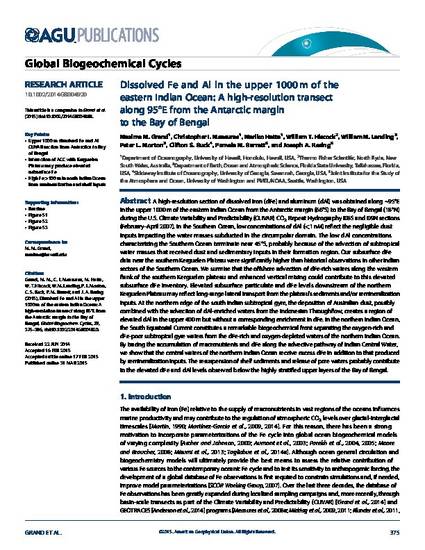
Article
Dissolved Fe and Al in the upper 1000 m of the eastern Indian Ocean: A high‐resolution transect along 95°E from the Antarctic margin to the Bay of Bengal
Global Biogeochemical Cycles
(2015)
Abstract
A high‐resolution section of dissolved iron (dFe) and aluminum (dAl) was obtained along ~95°E in the upper 1000 m of the eastern Indian Ocean from the Antarctic margin (66°S) to the Bay of Bengal (18°N) during the U.S. Climate Variability and Predictability (CLIVAR) CO2 Repeat Hydrography I08S and I09N sections (February–April 2007). In the Southern Ocean, low concentrations of dAl (<1 n M) reflect the negligible dust inputs impacting the water masses subducted in the circumpolar domain. The low dAl concentrations characterizing the Southern Ocean terminate near 45°S, probably because of the advection of subtropical water masses that received dust and sedimentary inputs in their formation region. Our subsurface dFe data near the southern Kerguelen Plateau were significantly higher than historical observations in other Indian sectors of the Southern Ocean. We surmise that the offshore advection of dFe‐rich waters along the western flank of the southern Kerguelen plateau and enhanced vertical mixing could contribute to this elevated subsurface dFe inventory. Elevated subsurface particulate and dFe levels downstream of the northern Kerguelen Plateau may reflect long‐range lateral transport from the plateau's sediments and/or remineralization inputs. At the northern edge of the south Indian subtropical gyre, the deposition of Australian dust, possibly combined with the advection of dAl‐enriched waters from the Indonesian Throughflow, creates a region of elevated dAl in the upper 400 m but without a corresponding enrichment in dFe. In the northern Indian Ocean, the South Equatorial Current constitutes a remarkable biogeochemical front separating the oxygen‐rich and dFe‐poor subtropical gyre waters from the dFe‐rich and oxygen‐depleted waters of the northern Indian Ocean. By tracing the accumulation of macronutrients and dFe along the advective pathway of Indian Central Water, we show that the central waters of the northern Indian Ocean receive excess dFe in addition to that produced by remineralization inputs. The resuspension of shelf sediments and release of pore waters probably contribute to the elevated dFe and dAl levels observed below the highly stratified upper layers of the Bay of Bengal.
Disciplines
- Oceanography,
- Climate and
- Geology
Publication Date
March 1, 2015
DOI
10.1002/2014GB004920
Publisher Statement
This article was published in Global Biogeochemical Cycles, volume 29, and can also be found online at this link.
Copyright ©2015. American Geophysical Union. All Rights Reserved.
SJSU users: Use the following link to login and access the article via SJSU databases.
Citation Information
Maxime M. Grand, Christopher I. Measures, Mariko Hatta, William T. Hiscock, et al.. "Dissolved Fe and Al in the upper 1000 m of the eastern Indian Ocean: A high‐resolution transect along 95°E from the Antarctic margin to the Bay of Bengal" Global Biogeochemical Cycles Vol. 29 Iss. 3 (2015) p. 375 - 396 ISSN: 0886-6236 Available at: http://works.bepress.com/maxime-grand/8/
